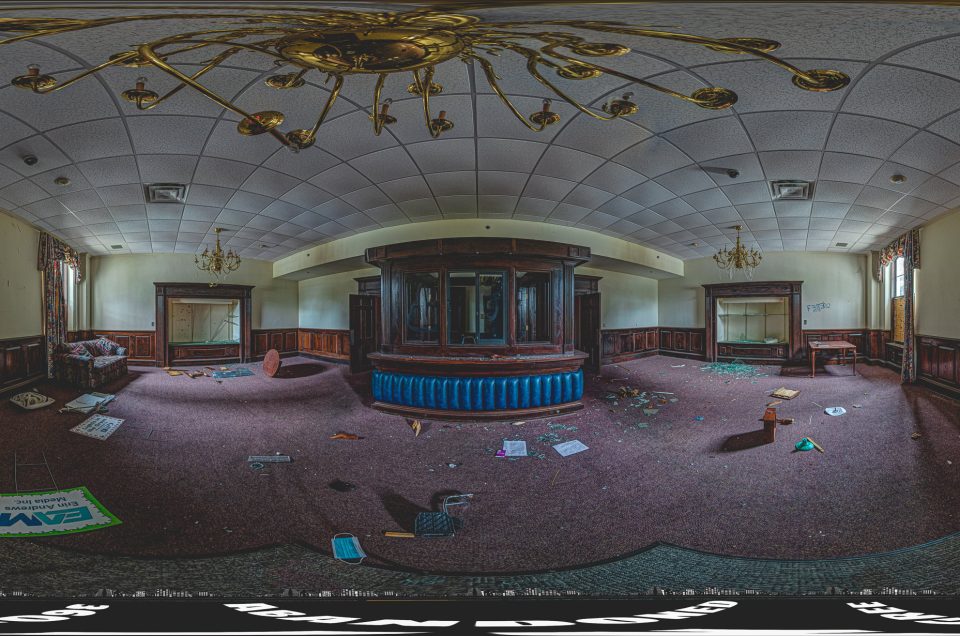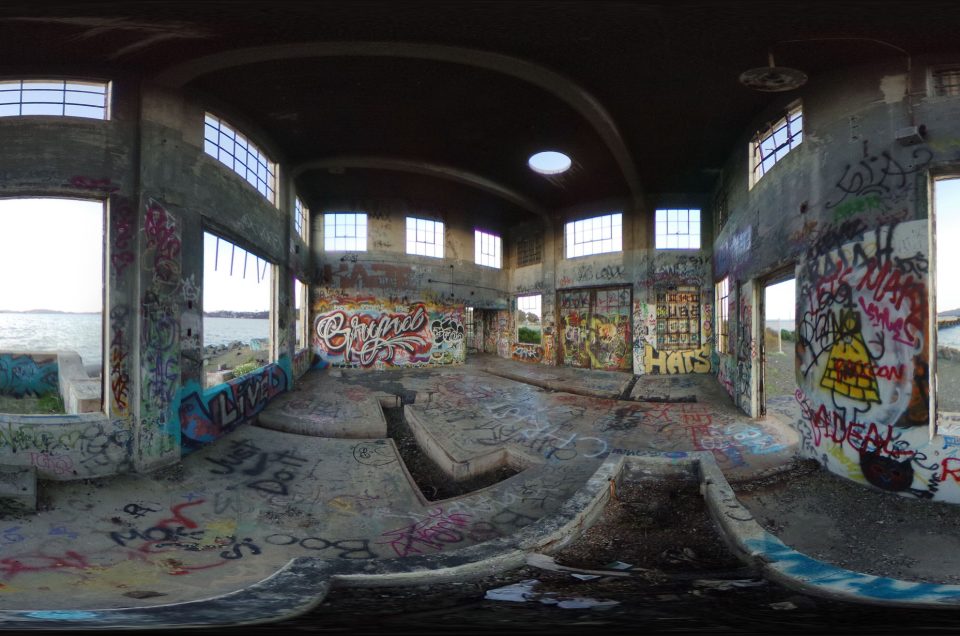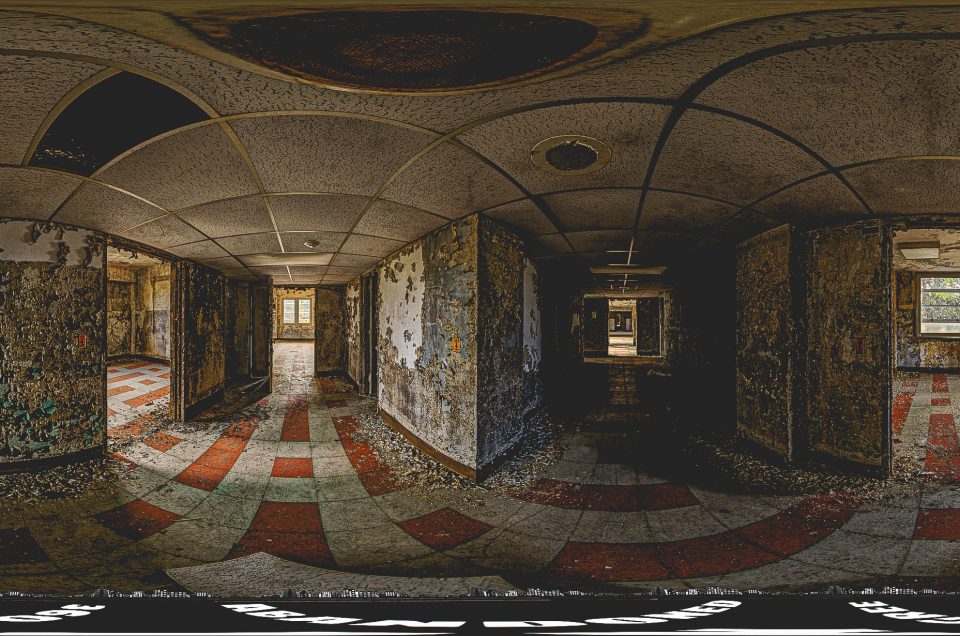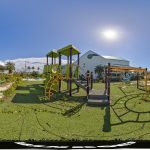Abandoned Charlton Memorial Hospital in Folkston, Georgia
Step inside the story of Charlton Memorial Hospital, a once-busy rural medical center in Folkston, Georgia where quiet corridors and shuttered wards hint at decades of care, urgency, and everyday life. For urban explorers, the textures of peeling paint, vintage fixtures, and stark clinical spaces offer a compelling look at how time reshapes a community landmark.
Experience the site through a self-guided 19-image 360-degree panoramic virtual tour below, letting you pause in operating rooms, peer down echoing hallways, and study artifacts left behind—without crossing a single threshold. Use the immersive views to plan your narrative, capture details others miss, and appreciate the atmosphere that makes Charlton Memorial Hospital a standout in Georgia URBEX.
Click here to view it in fullscreen.
In the small town of Folkston, Georgia, tucked away in Charlton County, stands the Charlton Memorial Hospital, an eerie and fascinating site for urban explorers. Once a vital community hospital, it now lies abandoned – a time capsule of another era. This hospital was built in the early 1970s (reportedly around 1972) and served local residents for about four decades before shutting its doors in 2013. In its heyday, Charlton Memorial was the only hospital in Charlton County and a lifeline for this rural region. Today, its deserted halls and decaying rooms attract URBEX enthusiasts looking to step back in time and experience the haunting atmosphere of an abandoned medical facility. In this comprehensive guide, we’ll delve into the hospital’s history and operating years, the reasons behind its abandonment, any nicknames or legends associated with it, and practical urban exploring tips for those who venture into this forsaken Georgia hospital. The tale of Charlton Memorial Hospital is both a slice of medical history and an adventure into abandoned in Georgia exploration territory – informative, intriguing, and a bit spine-chilling. Let’s explore the rise and fall of this hospital and what you might encounter if you brave its empty corridors.
History of Charlton Memorial Hospital
Charlton Memorial Hospital opened its doors in Folkston in the early 1970s, fulfilling a critical need for healthcare in Charlton County. As a small rural hospital (around 25 beds at its peak), it was established to provide general medical care, emergency services, and basic inpatient treatment for the local community. For many years, it served proudly as the sole hospital in the county – locals often simply called it the Charlton County hospital or the Folkston hospital. Charlton Memorial was a critical access hospital, a designation for rural hospitals with limited beds meant to ensure residents have emergency care within reach. It quickly became an essential part of life in Folkston, handling everything from routine check-ups and minor surgeries to emergency stabilization of patients who would then be sent to larger regional hospitals.
During its operating duration of roughly forty years, Charlton Memorial Hospital was more than just a medical facility – it was a cornerstone of the community. It provided jobs for area residents and had a close-knit staff of doctors, nurses, and support personnel who often knew their patients by name. In fact, the hospital became one of the largest employers in the area, at one point ranked as the second-largest employer in Folkston. Generations of Charlton County families were born, treated, or cared for within its walls. The hospital’s presence also gave Charlton County a chance to attract businesses and retirees, since having a local hospital is a sign of community vitality. Charlton Memorial even had a small heliport for medical evacuations and was equipped to handle urgent situations despite its limited size – a point of pride for local residents.
Community Role and Notable Moments
Throughout the late 20th century, Charlton Memorial Hospital saw its share of challenges and triumphs. Being a small facility, it had to work hard to keep up with medical advancements. It was not a high-tech institute, but it provided critical healthcare services to an area that would otherwise have to travel far for treatment. Over the years, the hospital added an emergency department, a handful of inpatient rooms, radiology and lab services, and even a modest surgical suite for minor procedures. It often coordinated with larger hospitals in nearby cities for patient transfers, especially for complex cases. Despite its limitations, many locals have fond memories of Charlton Memorial – from routine doctor visits to lifesaving interventions that happened right in the nick of time. The hospital also occasionally hosted community health fairs and vaccination drives, acting as a hub for public health in Charlton County.
One notable aspect of Charlton Memorial’s history is how tightly woven it was into the fabric of the community. Families would see the same caregivers year after year. The hospital auxiliary and volunteers (often local retirees or civic-minded residents) organized fundraisers and events to support the hospital, reflecting a deep sense of ownership among townsfolk. For example, it wasn’t unusual to have bake sales or charity drives whose proceeds went toward buying a new piece of equipment for the hospital’s lab or emergency room. Local newspapers would celebrate when Charlton Memorial received a new X-ray machine or when a long-serving nurse retired after decades of service. All these stories cemented the hospital’s reputation as a beloved, if humble, institution serving Folkston and surrounding rural areas.
Despite its importance to the community, Charlton Memorial Hospital remained a small rural hospital facing big challenges. By the turn of the 21st century, healthcare was changing rapidly – and rural facilities like Charlton Memorial struggled to keep pace. The hospital had a low patient census (some weeks saw only a handful of inpatients), and it lacked the specialized services that bigger hospitals offered. The population of Charlton County was relatively small (around 12,000 people spread over a large area), and many were older or uninsured, meaning the hospital often provided care without full reimbursement. Through the 1990s and early 2000s, Charlton Memorial did what it could to upgrade and adapt, but financial storm clouds were gathering on the horizon. Before long, these challenges would culminate in a fight for the hospital’s very survival.
Financial Troubles and Decline
By the late 2000s and early 2010s, Charlton Memorial Hospital was in a precarious financial position. Running a rural hospital is expensive, and the hospital was seeing more and more patients who couldn’t pay their bills or whose insurance (if they had any) reimbursed only a fraction of costs. The facility ended up providing a lot of uncompensated care – essentially treating people without adequate payment – which strained its budget. The CEO at the time, H.D. Cannington, noted that the hospital was carrying a tremendous amount of indigent care, meaning many patients were low-income and uninsured. Over the years, Charlton Memorial’s debts kept climbing, even as administrators tried various measures to keep the doors open. According to reports, the hospital’s debt grew from about $1 million around the year 2000 to nearly $5.8–6 million by 2013. This mounting debt was unsustainable for a small county-owned hospital.
A combination of factors contributed to the hospital’s decline. Low patient volume was a major issue – some days the hospital’s beds were almost empty, meaning very little revenue was coming in to cover fixed costs like staffing and utilities. On top of that, Charlton Memorial lacked high-tech services or specialty care that might attract more patients; cases that needed surgery, maternity care, or specialized treatments were usually sent elsewhere. This left the hospital handling mostly primary care and emergency stabilization, which on its own wasn’t lucrative. Additionally, changes in healthcare policy were hitting rural hospitals hard. Georgia, like many other states in the early 2010s, did not expand Medicaid coverage, which meant Charlton Memorial continued to see many patients with no insurance help, even as federal funds for rural hospitals were being reduced. It was a bit of a perfect storm: fewer paying patients, more uninsured patients, and shrinking subsidies.
Local officials and citizens were aware of the hospital’s troubles and desperately sought solutions. In mid-2013, as the situation grew dire, Charlton County residents circulated a petition called “Citizens United to Keep Charlton Memorial Hospital Open,” urging the county commission to find a way to save the hospital. Emotions ran high at public meetings; community members highlighted that the hospital was built because there was a need, and that need still existed. Ideas were floated, such as finding a larger health system to partner with, cutting services to reduce costs, or even repurposing part of the building for revenue. County officials agonized over the decision, but the financial reality was grim – the hospital was losing money rapidly, with no easy fix in sight. By the summer of 2013, the writing was on the wall: Charlton Memorial Hospital could not continue operating under these conditions.
Closure of the Hospital (2013)
In August 2013, Charlton Memorial Hospital officially closed its doors, becoming one of several rural Georgia hospitals to shut down that year. The Hospital Authority of Charlton County (which governed the facility) announced it would suspend all hospital operations due to “financial instability” – effectively, the hospital was bankrupt and could no longer pay its bills. This closure marked the end of approximately 40 years of continuous service to the community. The impact was immediate and deeply felt. Roughly 95 to 160 employees (reports vary) lost their jobs overnight, a huge blow in a small town. These included not just doctors and nurses, but support staff like lab techs, maintenance workers, and administrative personnel – many of whom had worked at Charlton Memorial for decades. The loss of income for those families and the ripple effect on the local economy was significant, as is often the case when a rural hospital shutters.
Local residents were left without an emergency room or hospital nearby. Suddenly, anyone in Charlton County needing hospital care had to travel much farther. The nearest full-service hospital is about 30–40 miles away (in St. Marys, GA, or over the Florida line) – a daunting distance in emergencies. This meant that what used to be a 5-minute drive to Charlton Memorial turned into a 45-minute or longer drive for an ER visit. Stories soon emerged illustrating the human cost of the closure: for instance, shortly after the hospital closed, a local woman critically burned in an accident had to wait for an ambulance to come from another county because all local EMS units were tied up transporting patients out of Charlton County. Such incidents underscored how the closure created dangerous gaps in care. Beyond medical care, there was a sense of loss – the community felt as if a part of its identity was gone. The hospital building that once bustled with activity and comforted the sick was now dark and quiet.
Interestingly, Charlton Memorial Hospital did not undergo immediate liquidation or demolition after closing. Instead, county officials chose to “mothball” the facility – keeping it intact in hopes that one day it might reopen. They literally locked the doors with everything still inside. Equipment, beds, supplies – all were left in place, awaiting a possible second life. “We’ve not sold any of our equipment, everything is ready,” said one hopeful manager shortly after the closure. The idea was that if the county could find a financial savior or a new healthcare partner, the hospital could be revived relatively quickly. For a time, a skeleton crew of staff remained employed just to maintain the building and safeguard medical records. This decision to mothball the hospital would later make it a remarkably well-preserved abandoned site, almost like a modern Pompeii of a hospital – frozen at the moment of its last day of operation. But in the short term, from 2013 onward, the building sat unused and the community had to adapt to life without a local hospital.
Attempts to Reopen or Repurpose
After the closure, there were several efforts and proposals to get some kind of medical services back into Charlton Memorial’s building. State officials recognized the rural healthcare crisis and in 2014 floated a novel idea: allow closed rural hospitals to reopen as freestanding emergency departments. Charlton Memorial was one of the prime candidates for this idea. The state created a new type of license to let small facilities operate ERs without the expense of running a full hospital. There was a glimmer of hope that Charlton Memorial Hospital might come back to life, at least partially. Doug Gowen, who stayed on to oversee the closed hospital, applied for this freestanding ER license and was optimistic that emergency services could be restored in Folkston. The community was cautiously hopeful – having even a small ER would be better than nothing, providing urgent care and stabilizing critical patients before sending them to larger hospitals.
Despite the good intentions, the challenge remained funding. Even a freestanding ER requires money for staffing, supplies, and operations, and it was unclear where that money would come from. Charlton County itself couldn’t shoulder the burden alone, and without state Medicaid expansion, no extra federal funds were on the horizon. Unfortunately, the plans to reopen as an ER stalled out. For a brief period, some urgent care clinics and an intermediate care center (operated in conjunction with a regional medical center) opened in Folkston to fill the void. These helped with day-to-day minor illnesses but were not round-the-clock hospitals. By the late 2010s, it was evident that Charlton Memorial Hospital’s inpatient days were over. The building remained, with occasional talks of repurposing it for other uses – ideas ranged from an assisted living facility to a training center, even rumors of converting it to a long-term care or rehabilitation center. However, as of the mid-2020s, none of those plans materialized, and the structure remains an abandoned hospital. This lack of reuse, while unfortunate for the community, meant that the interior stayed eerily intact – a goldmine for history buffs and urban explorers intrigued by an abandoned Georgia hospital that’s largely untouched since the day it closed.
Exploring the Abandoned Hospital Today (URBEX)
Walking up to the abandoned Charlton Memorial Hospital today, an urban explorer is immediately struck by how frozen in time it appears. The building itself is a single-story (with some sections two-story) brick structure typical of 1970s public architecture – functional, not too flashy. The hospital’s name is still mounted by the entrance, and signage like “Emergency” or “Outpatient” may still hang, now weathered and faded. Weeds and vines have started to creep over the sidewalks, and the parking lot has cracks sprouting grass. It’s eerily quiet; the only sounds might be the rustling of leaves or perhaps a loose door panel creaking. Yet, unlike many other abandoned places, this one isn’t completely gutted – Charlton Memorial was mothballed, meaning the county left it largely as-is when it closed. For urban explorers (URBEX adventurers), this is both exciting and sobering. You’re looking at a place that once saved lives and bustled with activity, now stilled. It’s a potent reminder of how quickly vital institutions can become relics.
Venturing inside (if one chooses to – note: trespassing is illegal and dangerous; explore at your own risk and preferably with permission), you’ll likely find that much of the hospital’s equipment and furniture is still there, gathering dust. Hallways might have gurneys and wheelchairs parked along the sides. Patient rooms contain bed frames, some with mattresses, and bedside tables strewn with old brochures or plastic water pitchers. The nurses’ station could have paperwork trays and faded memos dating back to 2013. In the surgery or emergency department, you might encounter eerie sights like an operating table left behind, or cabinets with supplies – all coated in a thick layer of dust. One account notes that before closing, there were weeks when the hospital had only one or two patients, and standing in those empty rooms, you can almost sense the loneliness that must have pervaded its final days. Peeling paint, cracked tiles, and the faint smell of mildew underscore that the building has been decaying slowly over the years. Sunlight filters in through blinds in patient rooms, illuminating particles in the air and giving the place a truly haunted ambiance. It’s not uncommon for explorers to describe the site as feeling like the staff and patients just vanished suddenly, leaving a ghost hospital behind.
Urbex Atmosphere and Legends
As with many abandoned hospitals, Charlton Memorial has an atmosphere that can be described as creepy yet fascinating. The silence in the corridors is heavy. Every footstep echoes, and small sounds – a drip of water from a leaky pipe, or a flutter of a bird that found its way indoors – can be startling. Many urban explorers relish this feeling: the adrenaline of being somewhere off-limits and the reflective sadness of seeing a place of healing in such a state. Abandoned medical facilities often spark the imagination, and Charlton Memorial is no different. Some explorers have whispered about feeling an “energy” in the building, and locals have even started to spin ghost stories about it. It’s not hard to see why – hospitals witness life and death, and an empty one naturally invites tales of spirits. There are rumors that the site is haunted, though these are anecdotal and unverified. For example, a few locals swapping stories have claimed to see a shadowy figure in a second-floor window at night or to hear an inexplicable echo of a hospital intercom. These kinds of stories are common in the URBEX community and add to the thrill, even if they’re taken with a grain of salt. Whether one believes in ghosts or not, there’s no denying the spooky vibe of walking through an abandoned emergency room where the only heartbeat is your own thumping pulse.
From a historical perspective, exploring Charlton Memorial is like opening a time capsule from 2013. You might find calendars on the wall turned to August 2013, or medical logs that abruptly stop on the closure date. The small-town hospital charm is still evident – murals or cheerful paint in the pediatric exam room, a bulletin board pinned with decades-old employee notices, perhaps even get-well cards left behind in a rush. The hospital’s laboratory might have notes or labels on equipment, and the cafeteria (if accessible) could have a menu board with the last meals served. Each artifact tells a fragment of the story: a story of a rural community that once had its own healthcare center and then lost it. Urban explorers often document these details with photography. In fact, the site has been featured on at least one abandoned places photoblog, where images showed scenes like a lonely hospital bed in an empty room and an ambulance entrance collecting dust. Those images captured the poignancy of a place frozen at the intersection of hope and despair – hope that it might reopen, and despair that it likely never will.
Urban Exploring Tips for Charlton Memorial Hospital
For those interested in urban exploring in Georgia, Charlton Memorial Hospital is a tempting destination, but it’s important to approach it safely and ethically. Here are some tips and considerations:
-
Legal Access: The hospital property is owned (or was owned) by the Charlton County Hospital Authority. Even though it’s abandoned, it is private property (publicly owned) and not legally open to the public. There may be “No Trespassing” signs. Getting caught could result in warnings or even charges. The best-case scenario for exploration is to seek permission. Perhaps contact local authorities or the county – occasionally, they might allow photography for historical purposes. If you do decide to enter without permission, know that you are taking a risk. Urban explorers often follow the mantra “take nothing but pictures, leave nothing but footprints,” and in this case, also add “do not get caught.”
-
Safety First: Abandoned hospitals can be dangerous. Charlton Memorial has been closed since 2013, which means at least a decade of no maintenance. Floors might be weak from water damage (especially if the roof has leaks). There could be broken glass, sharp metal edges, or even leftover chemicals in the lab areas. Mold and asbestos are real concerns in old buildings – wearing an appropriate mask (respirator) is wise to avoid inhaling hazardous dust or mold spores. Also, animals might have taken up residence; it’s not uncommon to encounter bats, rodents, or snakes in rural Georgia abandonments. Always watch your step and have a reliable flashlight, even in daytime, because interior rooms can be very dark (the power is obviously long since shut off).
-
Go with a Buddy: It’s highly recommended not to explore places like this alone. Bring at least one friend who is also interested in URBEX. Not only is it safer (someone can help if you get hurt), but it’s also helpful to have an extra set of eyes and hands while navigating the site. Plus, experiencing the eeriness with a friend is part of the fun! Make sure someone outside of your group knows where you are, too, in case of emergency. Cell phone reception can be spotty indoors, but in Folkston you should have a basic signal – still, don’t rely on phones; have a plan.
-
Equipment and Prep: Wear sturdy shoes (boots preferably) and long pants/long sleeves despite Georgia’s heat, because you may encounter debris or brush. Bring a good flashlight with extra batteries. If you’re into photography, this site is a gem – so a camera (and tripod for low light) will help you capture those haunting shots of the abandoned hospital halls. Some explorers bring first-aid kits, which is a prudent idea given the environment. It’s also good to explore during daylight if possible – not only for better photos but also for safety/visibility. Night explorations ramp up the creep factor but also the risk (and legality issues if police see lights inside). Here is a page we have dedicated to Urban Exploring Gear.
-
Respect the Site: As an urban explorer, you should aim to respect the history and integrity of Charlton Memorial. This means: do not vandalize anything, do not steal souvenirs (besides being unethical, taking anything could potentially be considered theft of county property), and try not to damage the building as you move through it. Sadly, some abandoned places eventually suffer graffiti or looting; by all accounts, Charlton Memorial remained mostly untouched for years after closing. Keeping a low profile helps it stay that way. Also, consider the context – this was a place of healing that many in the community still remember. Treat it with a bit of reverence. Some explorers even report feeling a sense of melancholy walking through, thinking of all the patients who passed through these rooms. It’s a good mindset to have: you’re there to document and experience, not to disrupt.
-
Local Conditions: Folkston is a small town, and an outsider poking around the old hospital might draw attention. Be polite and discreet. If a neighbor or local asks what you’re doing, being honest (for example, expressing interest in the history and taking photos) can go a long way. Sometimes people will share their personal stories about the hospital if they see you’re genuinely interested, which can enrich your experience. However, also be prepared to be told to leave – if that happens, it’s best to politely comply. There’s always another day. Law enforcement in a small town will know immediately that the hospital is not an authorized hangout, so avoiding a run-in is ideal.
Exploring Charlton Memorial Hospital can be an adventurous and enlightening urbex experience. It offers a rare glimpse into a fully equipped community hospital that’s been left to the elements. The combination of medical history and the poignancy of its story – a rural hospital succumbing to economic pressures – gives this site a special place in the catalogue of abandoned places in Georgia. If you venture there, you’ll not only get an adrenaline rush from the creepy atmosphere, but you’ll also walk away with a deeper appreciation of how important healthcare is to a community and what it means when it’s lost. In the hushed hallways where nurses once hurried and patients worried, you now only hear your own echoing footsteps – it’s equal parts unsettling and fascinating.
Conclusion
Charlton Memorial Hospital in Folkston, GA, stands as a silent monument to the past – a once-busy rural hospital now turned ghostly shell. Urban explorers who visit will find a place rich in history and atmosphere: from its founding in the 1970s to its closure in 2013 due to financial strain, every corner of the hospital tells a story. Old medical equipment and records lie untouched, reminding us that this institution was abruptly frozen in time. The reasons for its abandonment highlight a broader tale of rural healthcare challenges, with rising debts and too few patients making it impossible to continue. For about forty years, Charlton Memorial delivered babies, mended broken bones, and cared for the sick in Charlton County – and its local nickname as the county hospital underscores how beloved it was.
Today, as one of the creepiest abandoned places in Georgia, Charlton Memorial Hospital draws curious adventurers. It offers an experience that is both educational and eerie – educational in that it forces one to confront the real-life saga of a community losing its hospital, and eerie in the classic way abandoned hospitals are, complete with peeling paint and possible ghostly whispers. From an SEO perspective for urban explorers, this site hits all the key interests: it’s an abandoned hospital in Georgia with a compelling backstory, it’s a prime spot for urban exploring in Georgia, and it’s known in the URBEX world as a relatively accessible (though officially off-limits) time capsule of a medical facility. Whether you’re drawn to it for photography, history, or the adrenaline of exploration, Charlton Memorial will not disappoint – it stands as a reminder that even institutions meant to care for us can themselves become victims of hard times.
In closing, the tale of Charlton Memorial Hospital is a mix of history and adventure. Its walls witnessed the full spectrum of human life – joy, pain, hope, loss – and now they stand empty, speaking volumes to those willing to listen. For urban explorers, it’s an opportunity to step cautiously into the past and emerge not only with exciting stories and images, but also with a sense of respect for the fragile nature of rural communities and their lifelines. Charlton Memorial may be abandoned, but it is certainly not forgotten. Each explorer who walks its halls helps keep its memory alive, ensuring that the legacy of this small-town Georgia hospital endures even as nature and time slowly reclaim the building.
If you liked this blog post, you might be interested in other abandoned hospitals, The Dayner House in Florida or the Hotel Polissya in the Ukraine.
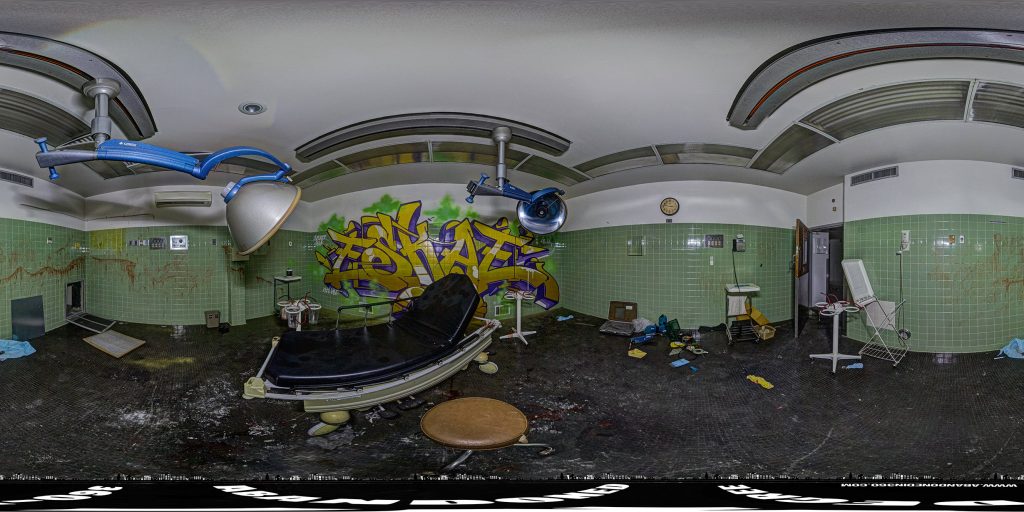
A 360-degree panoramic image captured inside one of the operating rooms at an abandoned hospital in rural Georgia. Photo by the Abandoned in 360 URBEX team
Welcome to a world of exploration and intrigue at Abandoned in 360, where adventure awaits with our exclusive membership options. Dive into the mysteries of forgotten places with our Gold Membership, offering access to GPS coordinates to thousands of abandoned locations worldwide. For those seeking a deeper immersion, our Platinum Membership goes beyond the map, providing members with exclusive photos and captivating 3D virtual walkthroughs of these remarkable sites. Discover hidden histories and untold stories as we continually expand our map with new locations each month. Embark on your journey today and uncover the secrets of the past like never before. Join us and start exploring with Abandoned in 360.
Equipment used to capture the 360-degree panoramic images:
- Canon DSLR camera
- Canon 8-15mm fisheye
- Manfrotto tripod
- Custom rotating tripod head
Do you have 360-degree panoramic images captured in an abandoned location? Send your images to Abandonedin360@gmail.com. If you choose to go out and do some urban exploring in your town, here are some safety tips before you head out on your Urbex adventure. If you want to start shooting 360-degree panoramic images, you might want to look onto one-click 360-degree action cameras.
Click on a state below and explore the top abandoned places for urban exploring in that state.
